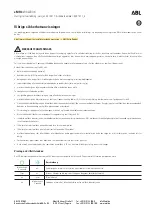
Tread depth
Most driving situations require the highest
possible tread depth. All tyres should have an
even tread depth on at least one axle. This is
especially true in wet or wintry road condi-
tions.
In most countries, the legally permissible
minimum tread depth is reached at 1.6 mm
(1/16 in) residual tread - measured in the
tread grooves next to the wear indicators
(observe deviating country-specific legal reg-
ulations). The tyres should have the same
tread depth, at the minimum on each axle
→ .
Observe any country-specific legal require-
ments relating to the permissible minimum
tread depths for winter and all-year tyres.
Tread wear indicators in tyres
The tread wear indicators show if a tyre is
worn down. The tyre must be replaced at the
latest when the tread depth is just down to
the tread wear indicator.
There are 1.6 mm (1/16 in) high wear indica-
tors →
in the tread base of the tyres.
Markings on the tyre sidewall indicate the
position of the tread wear indicators
WARNING
Worn tyres are a safety risk and can lead to
a loss of control of the vehicle and cause
serious injury.
·
Tyres must be replaced at the latest
when the tread is worn down to the
tread wear indicators.
·
Worn tyres have considerably less grip,
particularly on wet roads, which can
cause the vehicle to “float” along the
road surface (aquaplaning).
·
Worn tyres reduce the possibility of con-
trolling the vehicle well in normal and
difficult driving situations and increase
braking distance and the risk of skidding.
Tyre damage
Please refer to at the start of the chap-
Damage to tyres and wheel rims is often hid-
den → .
— If you suspect that a wheel is damaged,
slow down immediately and stop the vehi-
cle as soon as it is safe to do so.
— Check the tyres and wheel rims for dam-
age.
— Do not drive on if a tyre is damaged.
— Changing a damaged wheel → page 343.
Seek expert assistance for this if necessa-
ry.
Or: seal damaged wheel with the break-
down set and inflate → page 348.
— If there is no visible damage, drive slowly
and cautiously to the next qualified work-
shop in order to have the vehicle checked.
Embedded foreign bodies in the tyres
— Leave the foreign body in the tyre if it has
entered the inner tyre. Foreign bodies that
are stuck between the tyre tread blocks
can be removed.
— Changing a damaged wheel → page 343.
Seek expert assistance for this if necessa-
ry.
Or: seal damaged wheel with the break-
down set and inflate → page 348.
— Check and adjust the tyre pressure.
— Go to a qualified workshop. Volkswagen
recommends using a Volkswagen dealer-
ship for this purpose.
—
On vehicles with mobility tyres:
leave the
foreign body in the tyre and go to a quali-
fied workshop. A sealant applied to the in-
side of the tyre tread encloses the foreign
body and seals the tyre temporarily.
Tyre wear
The tyre wear is affected by several factors:
— Style of driving.
334
Wheels and tyres
















































